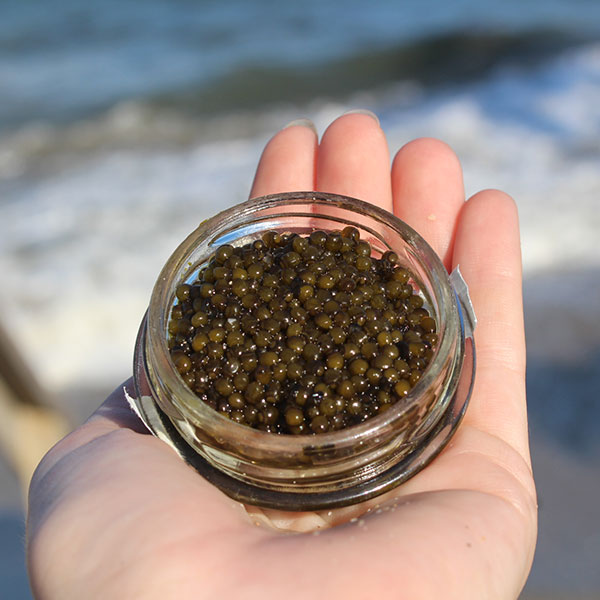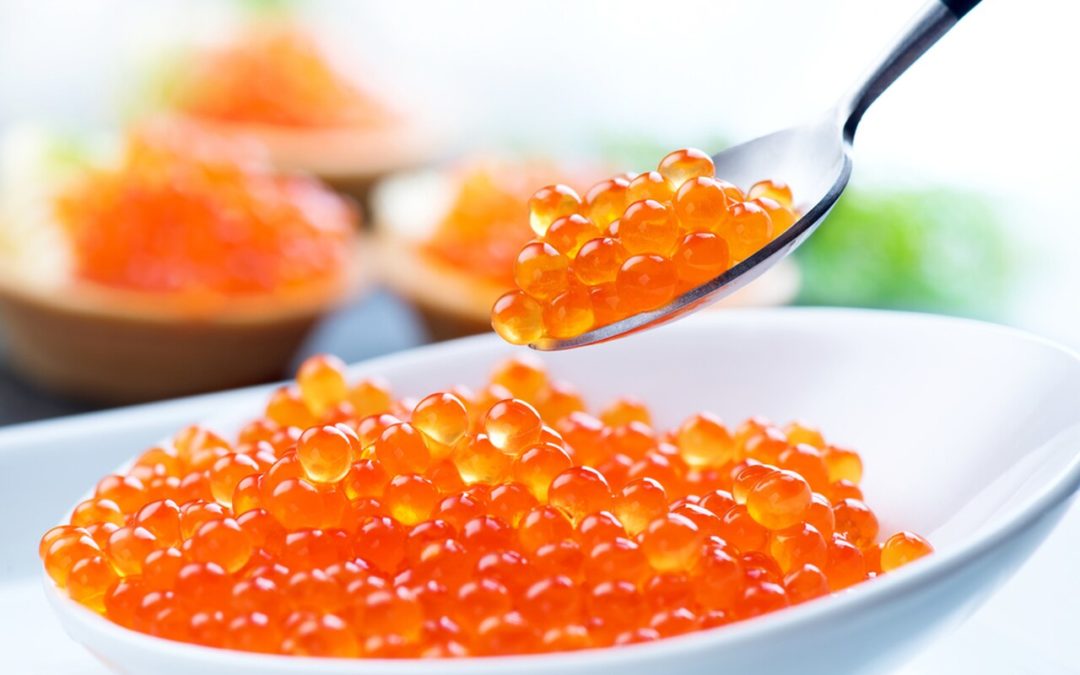
by HOCAFF Team | Oct 24, 2017 | General
Each original tin holds the eggs of an individual sturgeon. Caviar should never be “blended” or mixed with different fish. With the advent of aquaculture, a harvesting group of caviar-bearing sturgeon is almost always of the same age, size, & stock. They are also raised in the same conditions (water quality, temperature, etc.) and on the same diet. Biology, of course, can still play a part and make a unique “batch” per individual fish. Part of the initial grading process is to evaluate the quality and consistency of the original delivery. Rich will factor into account the size of the caviar grains (medium to large size) along with the color of the eggs, from light to dark.
By sampling the product, we are evaluating multiple factors – foremost the richness of flavor. Caviar – especially that of the Osetra sturgeon – should have a fresh, almost nutty flavor – and should be briny without being powerfully salty (“malossol” – Russian for “little salt” – is a common term used and is often on the caviar label itself.) The pleasing flavor needs to be equally offset by a firmness of egg texture – or the “pop” on the roof of the mouth – that is a traditional benchmark of superior caviar. Finally, the finish is evaluated on the palate – it should be creamy and flavorful, not bitter or “fishy.” All these factors play into the assessment of the quality grade assigned to the caviar.

by poshtone | Nov 28, 2016 | General
How to tell a good quality caviar
In our modern faced paced world, the lines between good, better and best often get skewed by savvy marketing gurus and cut-rate imitations. Caviar however, is one delicacy that cannot be faked.Ask anyone whose first experience with caviar was a $9.99 brand purchased from a neighborhood supermarket and they most likely will report an unfavorable impression of this highly coveted fare. The problem with being introduced to caviar via a subpar brand is that some may eschew a true gourmet opportunity to savor the authentic flavor of this exquisite cuisine. But frankly, unless your taste buds have merged with the real thing, knowing how to tell good quality caviar may always elude you.
Let’s face it, long before foie gras, champagne and truffles ranked as luxury food, caviar has been coveted by aristocracy.Some say just one taste of good quality caviar creates an indelible epicurean memory. And so, for anyone who truly knows how to tell a good quality caviar, the cliché “you get what you pay for” naturally comes to mind after eating caviar of an inferior grade. Even without consuming it, a caviar aficionado can tell you that no matter what claims the product labeling assert; a container of indiscernible beads of fish roe, steeped in a briny bath of artificial flavorings and food colorings cannot even be called caviar.
Criteria of Good Quality Caviar
- Caviar is a delicacy consisting of salt-cured fish-eggs of the sturgeon fish or Acipenseridae family.
- Taste of good quality Caviar is always lightly salted or treated to a process called “Malossol” which is Russian for little salt.
- The fish eggs or beads should be distinctly separate or beady and lustrous in appearance.
- When eating caviar, the roe should roll and pop in the mouth to release a buttery, melt in your mouth flavor boost on the tongue.
- The taste of good quality caviar evokes a subtle essence of the ocean versus an overpoweringly fishy aroma.
Traditionally, to be considered high quality caviar, the unfertilized eggs or roe must be harvested from the descendants of the prehistoric scale-less Beluga, Sevruga and Ossetra sturgeon population. There are, of course, exceptions to every rule; even for caviar.
For those that have acquired a taste for this exquisite luxury food but find it difficult to meet the stringent cost demands for traditional caviar, there are other equally desirable brands.Today’s cutting edge farming mechanisms facilitate more humane and sustainable caviar production and as well as enable producers to bring superior quality caviar to the marketplace. And, according to most modern caviar connoisseurs with experience on how to tell good quality caviar, agree that the flavor components of roe derived from the following farm raised sturgeons meet or in some instances, exceed the flavor component of their pricier counterparts.
- Kaluga Caviar’s roe size, iridescence and sumptuous flavor closely mimics that of the endangered Beluga sturgeon which is considered to be the best caviar in the world.Kaluga caviar with its delectable nutty essence is harvested from the Huso Dauricus and Acipenser Schrenckii sturgeon.
- Royal White Sturgeon Caviar is native to Italy and California. As the largest of the fresh water Acipenser Transmontanus and the third largest species of the Sturgeon population after the Beluga and the Ossetra species, the pearls of this succulent caviar are large. light to dark brown in color with a distinctly nutty essence.
- American Hackleback caviar is an excellent alternative to Caspian Ossetra sans the exorbitant price point. Although slightly smaller, the eggs of these fast-growing sturgeons are firm with hues that can range from light to dark brown. The subtle sweetness of this high-quality caviar is enhanced by a nutty and mildly buttery flavor.
If you are wondering where to buy caviar, may we suggest that you first by-pass the low-cost grocery store brands until you have experienced a truly good quality caviar.
Learn more about how to tell a good quality caviar by following House of Caviar and Fine food online or on Facebook. Since all our caviar products meet the strictest importation and quality standards you can also feel secure that you are getting the highest quality, purest and freshest caviar and gourmet products when you visit our online store.


